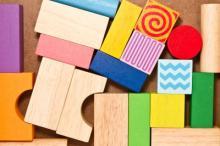
Building blocks offer hours of open-ended play and learning, and block play has been a classroom mainstay in early childhood and elementary school education for years. Block play was emphasized and studied by early educators, such as Froebel, Montessori, Hill, and Pratt. Their theories that encouraged giving children physical objects to play with as the basis for learning was revolutionary in the 19th and early 20th centuries.1
Alphabet blocks are thought to be one of the first educational toys designed specifically for children, and they were seen as essential tools for learning for young children as early as in the 17th century. The idea of using alphabet blocks with children was to encourage learning to read and spell in an enjoyable way.2
Friedrich Froebel felt that building with blocks helped children progress from the material to the abstract.3 He developed toys for inventive play that he called “gifts” and designed a large box of 500 wooden building blocks for children in his kindergarten.4
In 1905, Patty Smith Hill questioned the small size of the play items of Froebel and the sedentary play they encouraged. She developed the Hill Blocks, which were larger in size that required the cooperation of several children to construct a building. The larger size and weight of the blocks encouraged large-motor activity as well as social play.5
The blocks developed by Maria Montessori were a series of sensory blocks that were designed to isolate a specific attribute, such as height, length, width, depth, or color. She felt that the use of blocks as a systematic training of the senses led to children understanding their world.6
Caroline Pratt was an American educator of young children who developed wooden unit blocks to use in her school in 1914. Unit blocks were standard sizes and proportioned as a multiple or fraction of the unit block to aid in understanding math concepts as well as developing creativity and imagination as children built structures with them.7
A colleague of Pratt’s, Harriet Johnson, identified the stages of block building. As children move through these stages, their cognitive development, motor skills, and social growth can be observed:
- Stage 1: Blocks are carried by younger children, but not used for construction.
- Stage 2: Building begins with children mostly making rows with similarly shaped and sized blocks on the floor or attempting to stack the blocks vertically.
- Stage 3: Children begin making bridges using two blocks to support a third, which reflects understanding of spatial relationships.
- Stage 4: Children learn to place blocks to make enclosures of different sizes and shapes.
- Stage 5: More imaginative structures are built and children develop their understanding of symmetry.
- Stage 6: The naming of structures introduces dramatic play and their block play becomes artistic.
- Stage 7: Children engage in symbolic play as blocks are used to represent things they know, such as cars, airplanes, houses, and cities, as well as to stimulate dramatic play activities.8
Many important childhood development and learning skills are gained through block play. Math and science skills include concepts of space, shape, comparisons, size, order, number, counting, patterns, classifications, and gravity to name a few. Block play can develop physical skills, such as fine motor control, coordination, visual perception, spatial orientation, eye-hand coordination, and balance. Some language and literacy skills include labeling, vocabulary, planning, sequence, order, representation, and symbols. As children play together with blocks they develop social and emotional skills, such as cooperation, problem solving, making choices, risk taking, trial and error, creativity, and self-regulation.9
Recent studies and those dating back to the 1940s have shown that children who have had block play experience absorb math concepts better and achieve better math grades and standardized test scores in later school years. Children have also been shown to score significantly better on language acquisition tests.10 There is also a strong correlation evidenced in the corporate world that those who played with blocks and other construction activities as children are more equipped to problem solve and think creatively as described in the book by Dr. Stuart Brown, Play: How It Shapes the Brain, Opens the Imagination, and Invigorates the Soul.11
- 1. Hewitt, Karen. “Blocks As a Tool for Learning: Historical and Contemporary Perspectives.” Young Children. January 2001. NAEYC. < http://www.naeyc.org/files/yc/file/Hewitt0101.pdf > 30 Nov. 2011.
- 2. Richford, Nannette. “History of Alphabet Blocks.” eHow. < http://www.ehow.com/about_4597646_history-alphabet-blocks.html > 7 Dec. 2011.
- 3. LeBlanc, Miriam. “Friedrich Froebel: His life and influence on education.” Community Playthings. < http://www.communityplaythings.co.uk/resources/articles/friedrich-froebel.html > 21 Dec. 2010.
- 4. “Who Invented Kindergarten?” German Culture.com. < http://www.germanculture.com.ua/library/weekly/kindergarten.htm > 21 Dec. 2010.
- 5. Op. cit., Hewitt.
- 6. Op. cit., Hewitt.
- 7. “Wooden Blocks & Wooden Toys.” Old Fashioned Blocks. < http://www.oldfashionedblocks.com/index.html > 8 Dec. 2011.
- 8. Cuffaro, Harriet K. “Block Building: Opportunities for Learning.” Community Playthings. < http://www.communityplaythings.com/resources/articles/blocks/blockbuilding.html > 30 Nov. 2011.
- 9. “Block play: Classroom essentials.” Texas Child Care Quarterly. Summer 2009. Texas Child Care. < http://www.childcarequarterly.com/summer09_story2a.html > 30 Nov. 2011.
- 10. Spencer, Kyle. “With Blocks, Educators Go Back to Basics.” The New York Times. November 27, 2011. < http://www.nytimes.com/2011/11/28/nyregion/with-building-blocks-educators-going-back-to-basics.html > 30 Nov. 2011.
- 11. Anderson, Charlotte. “Blocks: A Versatile Learning Tool for Yesterday, Today, and Tomorrow.” Young Children. March 2010. NAEYC. < http://www.naeyc.org/files/yc/file/201003/HeritageWeb0310.pdf > 9 Dec. 2011.

